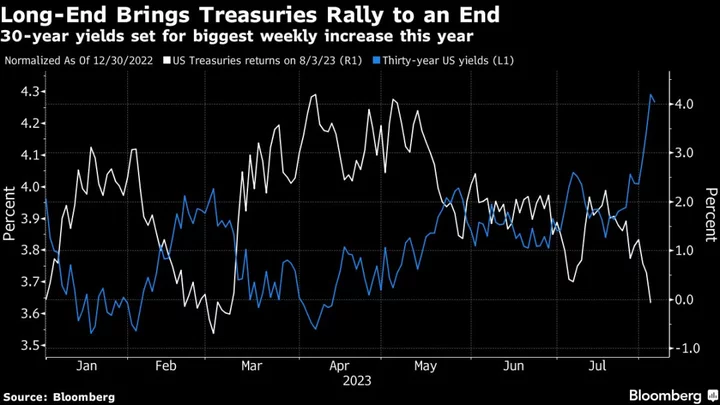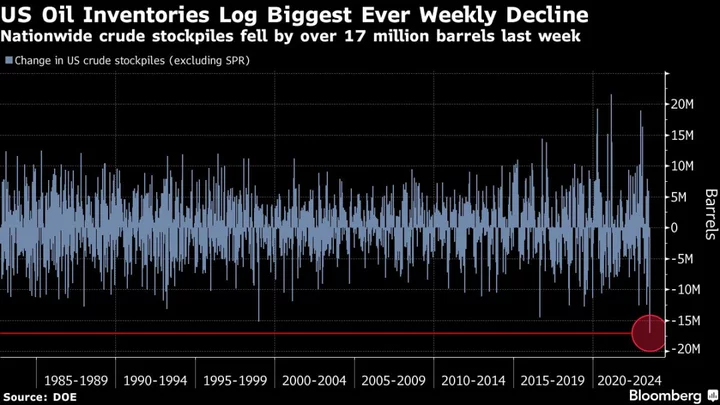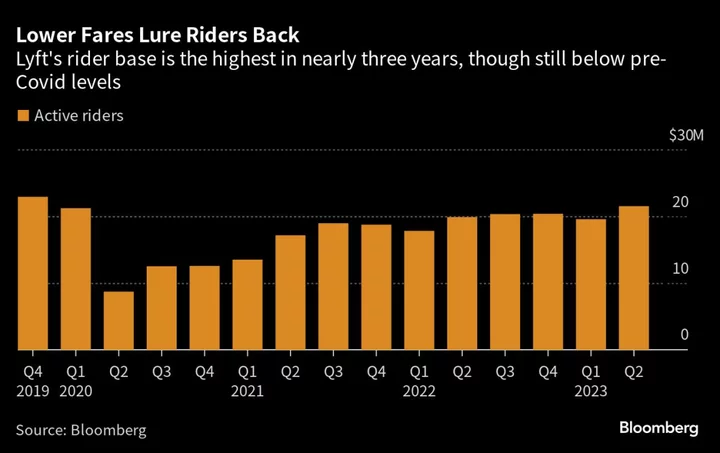The Treasury yield curve has steepened this week, but the shift is unnerving investors as it comes through a painful selloff in longer bonds rather than the rally in shorter debt most expected.
Yields on 30-year Treasuries climbed above their five-year peers Thursday for the first time since June as long bonds headed for their worst week since December. The slide in longer debt came just as client surveys showed bullish bets were close to the highest in more than a decade in anticipation Federal Reserve policy tightening will lead to a recession.
Instead, resilient economic data and better-than-forecast earnings are persuading traders the Fed will tame inflation without a severe slowdown, leading them to demand higher yields to own longer maturities. The long end is also being pummeled by plans for increased issuance and Fitch Ratings’ move to cut its US credit ranking.
“There’s been a pretty consistent theme of ‘go with the momentum’ despite bond-friendly data showing cooling inflation pressures,” said Amy Xie Patrick, head of income strategies at Pendal Group in Sydney, who recently went neutral on longer-term debt.
“This looks like a ‘no landing’ view being reflected as the curve bear steepens. Surely, didn’t we all expect that the next time the curve had any steepening momentum, it would be the bull steepening that signaled the start of the recession?” she said.
A bear steepening occurs when longer-maturity yields rise faster than shorter-maturity ones. At one stage on Thursday, the 30-year yield was two basis points higher than its five-year peer, after being as much as 45 basis points below it in early July. Long-bond yields have jumped 26 basis points this week, versus a 12 basis-point increase for five-year notes.
One trigger for the slide in longer debt was the Treasury’s decision to boost the size of its quarterly bond sales for the first time in more than two years this week to help finance a surge in budget deficits. The department said it would sell $103 billion of longer-term securities at next week’s quarterly refunding auctions, more than most dealers had expected.
The Bank of Japan’s decision last week to allow benchmark 10-year yields to climb above 0.5% has added to the global debt selloff.
The slide comes just as bond bulls such as JPMorgan Asset Management’s Bob Michele have doubled down on their conviction for a rally. Optimism the Fed is nearing the end of its tightening cycle likely encouraged fresh buying of bonds, Bank of America strategists said in a recent survey. JPMorgan Chase & Co.’s said its clients were near the most bullish on Treasuries since 2010.
Momentum Left
“My suspicion is there’s some momentum left” in the selloff, said Vishnu Varathan, executive director and head of economics and strategy at Mizuho Bank Ltd. in Singapore. “One of the drivers for that is the supply dynamics of it, with the debt overhang becoming more of a structural issue. Also because data in the US continues to be fairly upbeat, the reduction in long-end yields from recession risks has dissipated.”
Investor Bill Ackman said this week he’s making sizable bets on declines for 30-year Treasuries, and cited plans for increased bond sales as a key concern.
There are also signs investors are switching funds toward shorter securities, where yields are still above 5%. Money-market fund assets climbed to a record of $5.52 trillion in the week ended Aug. 2, while Elon Musk said Thursday short-term Treasury bills are “a no-brainer.”
Nervous Nomura
Given the risk Friday’s US payrolls data will add to signs of labor-market strength, even those who expect longer bonds to bounce back over the medium term are reluctant to buy just yet.
“We would be nervous about entering long positions at the long end of the curve here,” said Andrew Ticehurst, a rates strategist at Nomura Holdings Inc. in Sydney. “The other issue, which has been lurking in the background is the BOJ’s tweak. There is some global market nervousness that higher Japanese yields will mean Japanese investors keep more of their money at home.”
--With assistance from Ruth Carson.
(Adds details on positioning in second, ninth paragraphs.)









